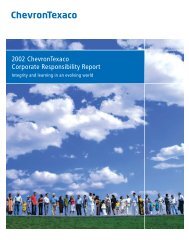Next* Magazine, Issue 5 - Chevron
Next* Magazine, Issue 5 - Chevron
Next* Magazine, Issue 5 - Chevron
You also want an ePaper? Increase the reach of your titles
YUMPU automatically turns print PDFs into web optimized ePapers that Google loves.
PHOTO: MARC MARRIOTT<br />
Building on decades of technological advances, <strong>Chevron</strong><br />
is scheduled to become the world’s largest producer<br />
of premium base oil when its new base oil manufacturing<br />
facility is completed by year-end 2013 at the Pascagoula,<br />
Mississippi, refinery. The new facility is expected to enable<br />
the company to meet the growing demand for premium base<br />
oil, which higher-performance engines need. Base oils are<br />
the building blocks used to manufacture lubricants, such as<br />
motor oil, for consumer and commercial uses.<br />
The key technology involved in the company’s base oil<br />
production is ISODEWAXING technology, which <strong>Chevron</strong><br />
invented and began using commercially in 1993. This technology<br />
enables the removal of essentially all undesirable sulfur<br />
and nitrogen molecules and transforms the waxy molecules<br />
into high-quality base oil. It also reduces the pour point, the<br />
lowest temperature at which a lubricant can flow. As a result,<br />
the ISODEWAXING catalytic process significantly increases<br />
the yield of lubricant base oil over solvent dewaxing—the<br />
conventional method for base oil dewaxing at the time<br />
ISODEWAXING was invented.<br />
This technology represented an advance by combining<br />
three steps in base oil production—hydrocracking, catalytic<br />
dewaxing and hydrofinishing.<br />
Hydrocracking applies high temperatures to remove most<br />
of the sulfur and nitrogen. Catalytic dewaxing removes wax<br />
molecules. And hydrofinishing uses sophisticated catalysts to<br />
convert the remaining impurities to stable base oil molecules.<br />
By combining the all-hydroprocessing route and replacing<br />
the catalytic dewaxing step with ISODEWAXING technology,<br />
<strong>Chevron</strong> also lowered capital and operating costs.<br />
Since the initial invention in 1993, <strong>Chevron</strong> has commercialized<br />
seven more dewaxing catalysts with improved yield<br />
and product quality. Further, the company is a world leader<br />
in hydrofinishing and has commercialized four generations<br />
of hydrofinishing catalysts to improve base oil color and<br />
stability.<br />
“This technology took a different path than solvent processing.<br />
Solvent processing inefficiently removes the poorperforming<br />
molecules; hydroprocessing converts those same<br />
molecules into premium-quality base oils,” said Doug Bea,<br />
2/ 3<br />
About two-thirds of<br />
the world’s premium<br />
base oil is manufactured<br />
with <strong>Chevron</strong>’s<br />
ISODEWAXING<br />
technology<br />
The Pascagoula Refinery in Mississippi is the site of <strong>Chevron</strong>'s new<br />
manufacturing facility for premium base oils, which are the building<br />
blocks for lubricants such as motor oil.<br />
Pascagoula Base Oil Project commercial manager. “It makes<br />
a much cleaner oil that looks like water, unlike the old technology<br />
that produces an amber or honey-colored oil.”<br />
“The ISODEWAXING process allows us to significantly<br />
increase the production of premium base oil products, gives<br />
us greater flexibility with crude feedstocks, and gives the<br />
consumer higher fuel efficiency and lower emissions,” said<br />
Barbara Burger, vice president of Supply Chain and Base Oil.<br />
About two-thirds of the world’s premium base oil is manufactured<br />
with <strong>Chevron</strong>’s ISODEWAXING technology, and the<br />
proportion of premium base oils is expected to grow as new,<br />
all-hydroprocessing plants come on line. <strong>Chevron</strong> and its joint<br />
venture <strong>Chevron</strong> Lummus Global have licensed the technology<br />
to more than 15 base oil plants.<br />
Until now, <strong>Chevron</strong>’s base oil production has been<br />
concentrated in the Richmond plant and in the supply from<br />
<strong>Chevron</strong>’s GS Caltex joint venture in Yeosu, Korea. The<br />
Pascagoula project is intended to roughly double <strong>Chevron</strong>’s<br />
premium base oil production, serving markets in North<br />
America, Latin America and Europe.<br />
“The project will benefit both the company and the<br />
community,” said Patti Leigh, general manager of Base Oil.<br />
“The project will help us expand our business and provide an<br />
enormous boost for the local economy by generating about<br />
1,000 jobs during its construction phase.” ■<br />
<strong>Next*</strong> | 29

















